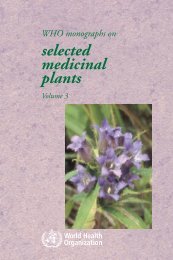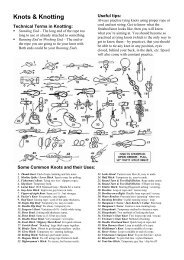Becoming Self-Sufficient for Six Months - Blog by Survival-Goods.com
Becoming Self-Sufficient for Six Months - Blog by Survival-Goods.com
Becoming Self-Sufficient for Six Months - Blog by Survival-Goods.com
Create successful ePaper yourself
Turn your PDF publications into a flip-book with our unique Google optimized e-Paper software.
cal leaders, military personnel, and civilians who hold mission-critical jobs in such<br />
fields as medicine, law en<strong>for</strong>cement, and public utilities. There<strong>for</strong>e, you might not be<br />
able to vaccinate your family until after the pandemic has passed. To <strong>com</strong>plicate matters,<br />
Tamiflu, the drug that is given to patients with severe flu, is difficult to obtain<br />
and is not effective unless it is administered within 48 hours of the onset of symptoms.<br />
So, get your Tamiflu A.S.A.P. After the pandemic starts it will be too late.<br />
When H5N1 does eventually evolve into a clade that is easily transmitted from person<br />
to person, it is expected to lose some of its lethality, but it could still be far deadlier<br />
than any flu the world has ever experienced. Many epidemiologists estimate that 50%<br />
of the global population will be<strong>com</strong>e sick with the flu and that 10% of the flu patients<br />
will die. This would result in 300 million deaths worldwide. In the United States<br />
alone, that would be approximately 15 million deaths. Even if only 33% of Americans<br />
be<strong>com</strong>e ill and only 1% die, that would still be a loss of 1 million people. Although<br />
nobody can predict when the H5N1 virus will finally give rise to a severe pandemic,<br />
the World Health Organization believes that it is just a matter of time. This is because<br />
migrating birds continue to spread the virus to domesticated birds, and because<br />
there are millions of people all around the world (including the U.S.A.) who live in<br />
close proximity to domesticated birds. These factors create a recipe <strong>for</strong> disaster, since<br />
it gives the virus numerous opportunities to per<strong>for</strong>m the genetic reassortments necessarily<br />
<strong>for</strong> effective human to human transmission.<br />
In addition to the risk from infected birds, there is a growing concern over H5N1’s<br />
potential to infect a variety of mammals–not just humans. There are confirmed cases<br />
of dogs and cats, both feral and domesticated, that have died of H5N1. The reports<br />
about cats is especially disturbing because cats have never had flu be<strong>for</strong>e. So, if it is<br />
true that the virus is capable of spreading to a variety of mammals, this could indicate<br />
that the much-feared genetic reassortments are taking place and that human to human<br />
transmission is now inevitable. You should also bear in mind that thousands of<br />
people have died from “flu-like” illnesses, but were never tested <strong>for</strong> H5N1, and there<br />
are cases that were confirmed post mortem, but did not test positive initially; there<strong>for</strong>e,<br />
it is impossible to know just how far this flu has already spread.<br />
The infection and death rates from the 1918 “Spanish Flu” suggest that over the<br />
course of a severe pandemic lasting several months, at least 33% of the global population<br />
will eventually be<strong>com</strong>e ill with the flu. There<strong>for</strong>e, we could expect that H5N1 will<br />
make one-third of the world’s labor <strong>for</strong>ce too sick to work <strong>for</strong> at least two weeks per<br />
person. In addition to the hours lost to employee illness, the global labor <strong>for</strong>ce could<br />
certainly suffer from an indefinite period of voluntary absenteeism, as healthy people<br />
begin to practice “social distancing” in an attempt to avoid contact with those who may<br />
be infected. There could also be a substantial number of otherwise healthy workers<br />
who must remain at home <strong>for</strong> weeks or months to care <strong>for</strong> sick family members; and, if<br />
schools and day-care centers are obliged to close their doors, a lot of working parents<br />
would have no choice but to remain at home with their children indefinitely.<br />
Beyond these temporary labor problems, substantial as they may be, it is likely that at<br />
least 100 million workers around the world will die from the next flu pandemic, including<br />
thousands of people who hold jobs that affect your family’s lifestyle. The net<br />
<strong>Be<strong>com</strong>ing</strong> <strong>Self</strong>-<strong>Sufficient</strong> <strong>for</strong> <strong>Six</strong> <strong>Months</strong> page 2
















